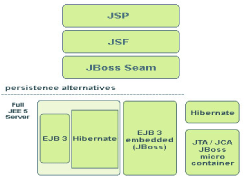|
|
|
JBoss Seam : Stitching JSF and EJB3 |
|
- use their application object as their UI object JBoss Seam : Stitching JSF and EJB3
Nov-07 Java Jazz Up 19
- use their application object as theirpersistent object
Now, the developers only need to create the set of core objects i.e. application objects.
JBoss Seam generates and manages a huge amount of code itself to flexibly control the behaviour of the entire code at the run times. Seam achieves this feature through a very rich set of annotations as Seam is consistent with the heavy use of annotations in JEE 5.
Annotations are there to declaratively control the things like how to generate and manage
the application code. Though the code generated and managed by JBoss Seam is not as flexible as tedious hand-crafted code written by the developers. But then, if we consider the amount of the code that the developers no more need to write, then the trade-off
in robustness and maintainability may justify the reduced flexibility.
Seam with new conversational context
JBoss Seam has highly reduced the tedious coding required to manage the states between the discrete UI pages. Seam achieves this by
providing a conversational context for maintaining application level attributes. Seam
allows a conversation to maintain over many
HTTP connections.
Now with seam application developers just need to declare an application object to maintain
it in the conversation scope and Seam ensures to make the instance available throughout the
conversation. It just requires to specify - when a conversation begins and when it should end.
Conversation implementation is a nice feature added to the JBoss Seam. This provides the ability to track and manage multiple concurrent conversations from the same user.
|
|
Seam’s Support for a myriad of persistence alternatives
Figure 4 illustrates the role of JBoss Seam
in managing persistence. Just it requires to add the appropriate annotations to the application object, and further Seam co-ordinates the required generation of code and the runtime interceptions.
For the actual persistence work Seam either uses EJB 3 CMP with a support in JEE 5 (i.e. currently known as Glassfish Server) or the most popular ORM i.e. Hibernate.
Figure 5 illustrates the most suitable persistence alternatives for JBoss Seam i.e. – JBoss Seam can use EJB 3 CMP to persist the application object.

Figure 5: Persistence alternatives for JBoss Seam
Now with Seam, Developers need not to develop any additional code to support this. Just they can use an entity bean for their application objects. This style of persistence is
perfect for application running inside a JEE 5 container – such as the JBoss Application
Server.
Seam’s flexibility to adapt the light-weight development environment
Now with Jboss Seam you can keep your application lightweight, and can rather do without any EJBs, as the Seam provides the
|
|
Nov 2007 | Java Jazz Up | 19 |
| |
|
| |
| View All Topics |
| All Pages of this Issue |
Pages:
1,
2,
3,
4,
5,
6,
7,
8,
9,
10,
11,
12,
13,
14,
15,
16,
17,
18,
19,
20,
21,
22,
23,
24,
25,
26,
27,
28,
29,
30,
31,
32,
33,
34,
35,
36,
37,
38,
39,
40,
41,
42,
43,
44,
45,
46,
47,
48,
49,
50,
51,
52,
53 ,
54,
55,
56,
57,
58,
59,
60,
61,
62,
63 ,
64,
65 ,
66 ,
67 ,
68 ,
69 Download PDF |
|
|
|
|
|
|
| |
| |
|